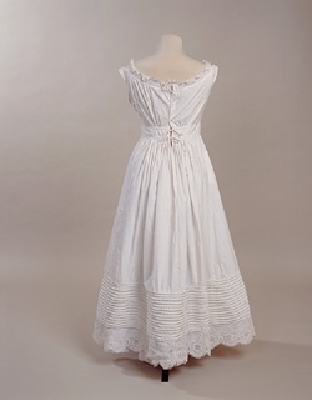petticoat
Summary
White cotton with high waist. Low, wide, round neck edged with embroidery and lace frill; piped armholes; front in one bias-cut section, back in two shaped sections, centre back fastening with drawstring at top and bottom of neck edging and at high waistband and two buttons; skirt front in one slightly flared section, two sections each side flared towards back, slit at hip in right back seam, centre back in two straight sections, closely gathered at centre waist; sixteen lines of piping at hem; edging of finer cotton scalloped and with openwork embroidery. (Fanny Jarvis)
Display Label
This petticoat is typical of women's underwear for the majority of the nineteenth century in that it is made of unpatterned white cotton, and that it has a full skirt providing bulk for the upper dress. In this case it also has rows of piping to give added weight to the hem, which is scalloped and trimmed with white openwork embroidery. The neckline is wide and low to ensure that it does not show under the dress, and the waistband, in this case, is just higher than the natural level. Highered waists like this were a fashionable feature at the beginning of the nineteenth century, intended to suggest an "Empire" silhouette, but by 1830 they had descended to a natural line again. This piped or rouleaux hem also gives more fullness to the skirt than was fashionable during the first decade of the nineteenth century. The red silk evening outfit shown below is typical of the type of dress which would have been worn over such petticoats, the fullness in the skirt provided by the layers of cotton below.
Object Name
petticoat
Date Created
1828-1835
Dimensions
Length: 135cm
Circumference (hem): 237cm
Waist: 75cm
accession number
1947.1934
Collection Group
Medium
Legal
© Manchester Art Gallery


